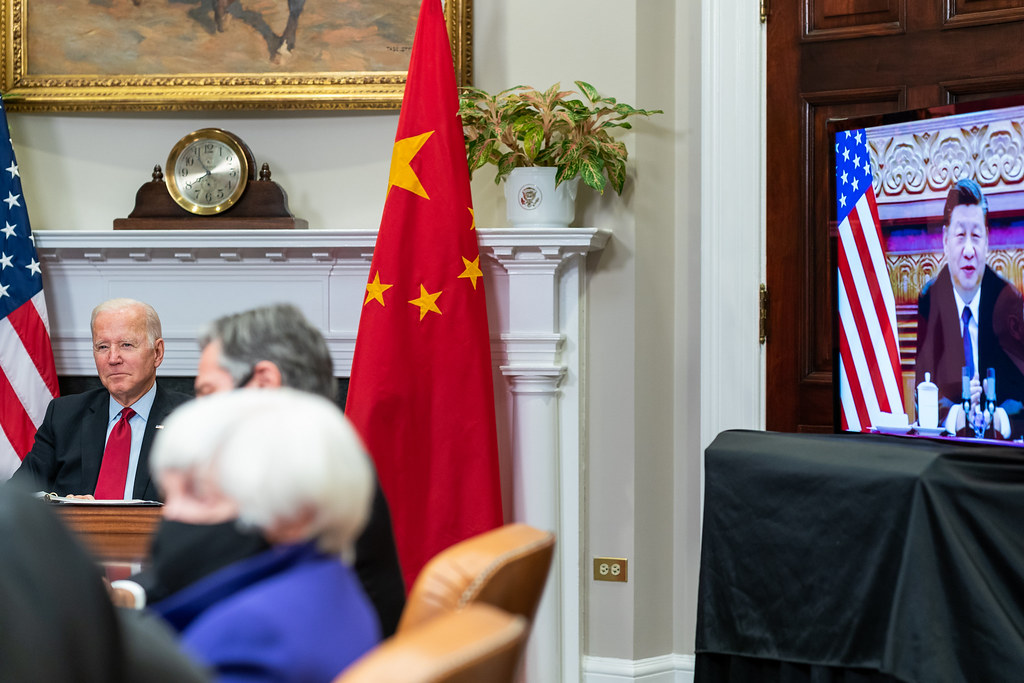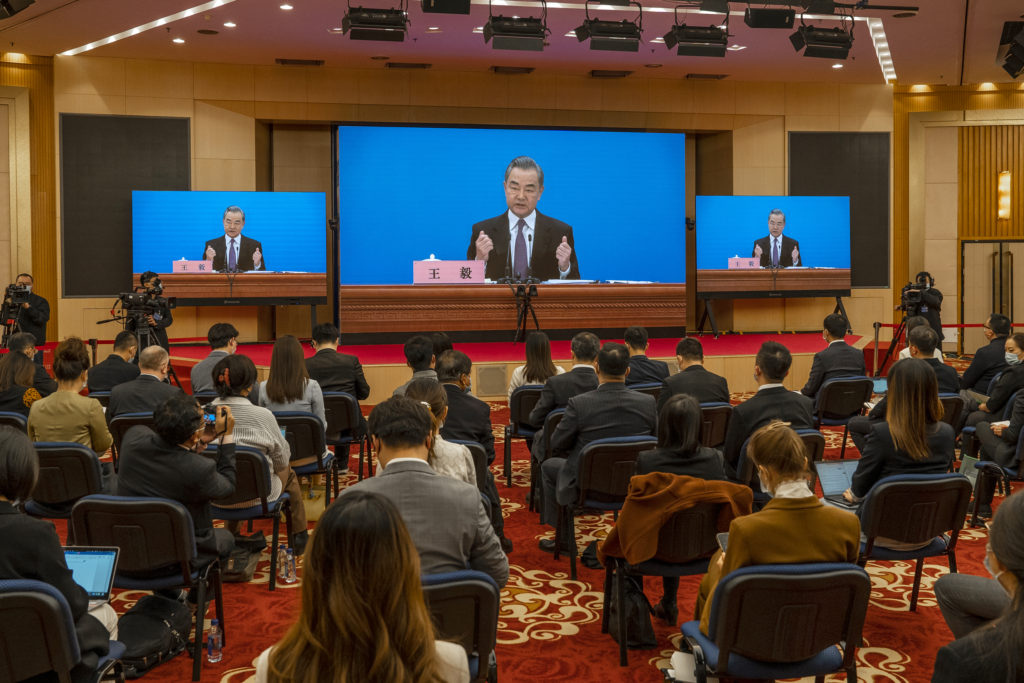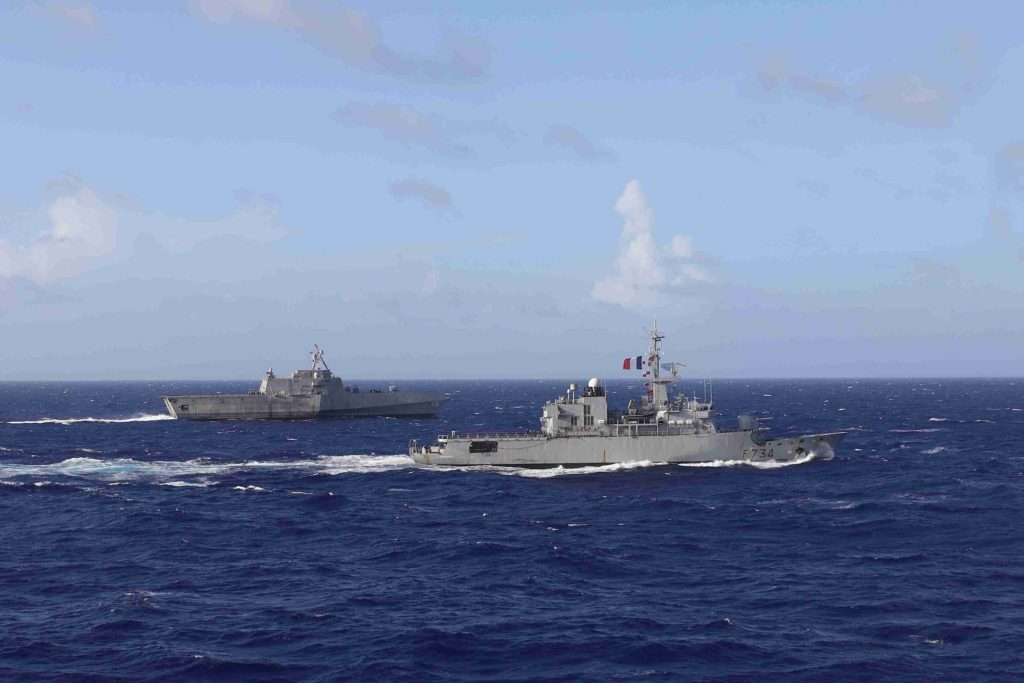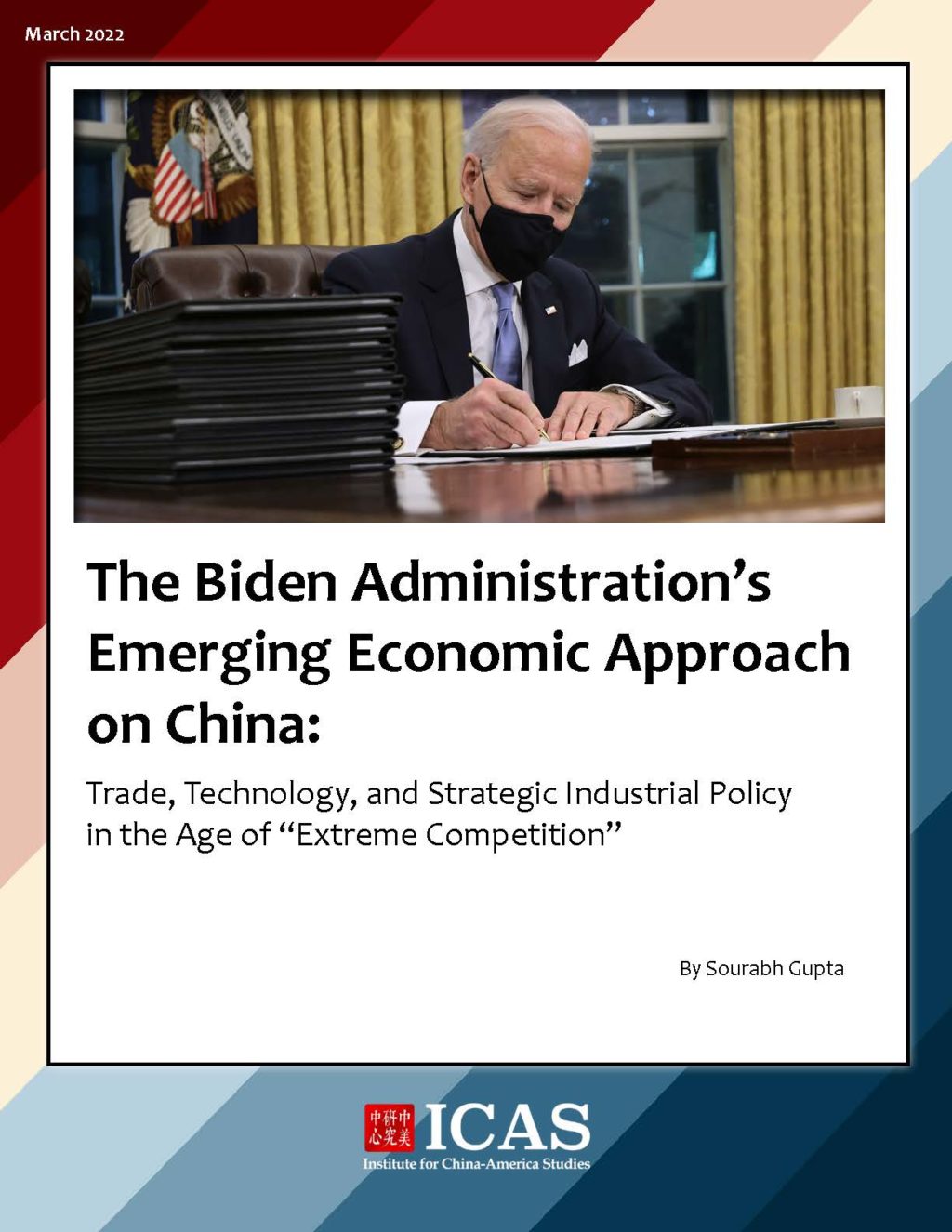
ICAS Bulletin (online ISSN 2836-3418, print ISSN 2836-340X) is published every other week throughout the year at 1919 M St NW, Suite 310, Washington, DC 20036.
The online version of ICAS Bulletin can be found at chinaus-icas.org/bulletins/.

– On March 21, the U.S. Department of State announced that it is imposing travel bans on several Chinese officials that it accuses of “repressive acts” against Uyghur Muslims in Xinjiang and anti-government dissidents in China and abroad.
– On March 17, U.S. President Joe Biden and Chinese President Xi Jinping held a virtual meeting covering a wide array of topics. Headlines focused on each nations’ differing approaches to the war in Ukraine as Biden reportedly warned Xi during the meeting that there would be “consequences” if Beijing attempted to help Moscow by circumventing U.S. sanctions on Russia.
– The Chinese readout of the call reported that Xi told Biden that “he who tied the bell to the tiger must take it off,” arguing that the U.S. and Europe played a role in forcing Putin’s hand. Xi also made it clear that China was ready to send humanitarian assistance to Ukraine and promote negotiations between Moscow and Kyiv.
– On March 14, Washington and Beijing both provided positive assessments of a meeting between National Security Advisor Jake Sullivan and Central Foreign Affairs Commission Director Yang Jiechi with each government calling the discussions “substantial” and “constructive,” respectively.
Associated News Sources:
“US hits Chinese officials with travel bans over ‘repressive acts’”, Al Jazeera, March 21
“Biden warns Xi of global backlash if China helps Russia’s attack on Ukraine”, CNBC News, March 18
“Biden warns China’s Xi not to help Russia on Ukraine”, The Washington Post, March 18 [Paywall]
“Biden warns Xi against helping Russia as US-China relations face ‘crossroads’ over Ukraine invasion”, USA Today, March 18
“Biden, Xi to speak as U.S. warns about China military aid for Ukraine war”, Reuters, March 17 [Paywall]
“U.S. Says China Talks on Russia Were a ‘Substantial Discussion’”, Bloomberg, March 14 [Paywall]

– On March 30, at a House Ways and Means Committee hearing, USTR Katherine Tai signaled that a good-faith effort to engage with China’s government on trade may be hitting its limits, marking a notable shift in tone.
– On March 25, a COVID-19 lockdown was imposed in Shanghai leading several plants to shut down amid delays at the city’s port, a critical part of global supply chains.
– On March 25, it was reported that Chinese companies and government officials are pressing Washington for details on how to comply with U.S. sanctions on Russia while continuing to conduct business there.
– On March 23, a U.S. judge freed the fourth-largest maker of telecommunications equipment—China’s ZTE Corp.— from its probation for violating U.S. sanctions on Iran.
– On March 23, USTR restored tariff exemptions for 352 categories of goods from China after a year-long review.
– On March 18, it was reported that many Chinese consumer technology firms—untouched by sanctions— have continued to operate in Russia despite the mass exodus of Western firms in the wake of the Ukraine war.
– On March 17, the Federal Communications Commission revoked its authorization for Chinese telecom firm Pacific Networks to operate in the U.S., citing security concerns.
Associated News Sources:
“Tai: U.S. must ramp up trade defense against China”, Politico, March 30
“Shanghai Covid-19 Lockdown Poses Fresh Test to Supply Chains”, The Wall Street Journal, March 28 [Paywall]
“China Damps U.S. Concern on Russian Sanctions by Drilling Into Their Details”, Bloomberg, March 25 [Paywall]
“Judge Frees China’s ZTE From Some U.S. Oversight”, The Wall Street Journal, March 23 [Paywall]
“U.S. Renews Tariff Exemptions for Some Chinese Imports”, The Wall Street Journal, March 23 [Paywall]
“Chinese Tech Companies Deepen Roots in Russia in Spite of U.S. Sanctions”, Lawfare, March 18
“FCC revokes U.S. authorization of Chinese telecom firm Pacific Networks”, Reuters, March 17 [Paywall]

– On March 29, Russian Foreign Minister Sergei Lavrov and China’s Foreign Minister Wang Yi met in Beijing and issued a joint statement cementing ties and condemning sanctions imposed on Moscow for invading Ukraine.
– On March 24, it was reported that there is much diversity of opinion in China regarding the war in Ukraine. Debates among experts and common people are revolving around whether the perceived threat of NATO justifies force.
– On March 20, Wang Yi told the press that China’s position on the Ukraine war—premised in opposing “external coercion or pressure…maintaining peace and opposing war”—is “in line with the wishes of most countries” and on “the right side of history.”
– On March 20, China’s Ambassador to the U.S., Qin Gang, appeared on CBS where he reiterated China’s hope for a peaceful resolution in the Ukraine war and added that condemnation of Russia “doesn’t solve the problem.”
– On March 16, thousands of Chinese WeChat users flocked to the comments of a translated version of Amb. Qin Gang’s op-ed in the Washington Post on the Ukraine war. Many netizens expressed dismay over the apparent contradictions in China’s stance before the comments on the post were hidden the following day.
Associated News Sources:
“China, Russia ‘more determined’ to boost ties, Beijing says”, Reuters, March 30 [Paywall]
“China hammers home its message of US blame for Ukraine war to domestic audience”, South China Morning Post, March 28 [Paywall]
“China on the right side of history over Ukraine war, foreign minister says”, Reuters, March 20 [Paywall]
“Ambassador says China promotes peace but won’t condemn Russia”, Politico, March 20
“On China’s Internet, Rare Flash of Anger at Beijing’s Position on Ukraine”, The Wall Street Journal, March 17 [Paywall]

– On March 28, the Biden Administrated requested $773 billion for the Pentagon, up 4% from the previous fiscal year, to focus on the “pacing” threat of China and the “acute” secondary threat of Russia.
– On March 28, the Philippines and the U.S. began their annual ‘Balikatan’ joint military exercise. Featuring 8,900 troops and amphibious operations, this will be the largest iteration of the exercise since 2015.
– On March 25, the Solomon Islands confirmed that it is in the process of drafting a security deal with China which could allow Beijing to deploy forces to protect its ventures or for policing operations at Honiara’s behest.
– On March 22, the Biden Administration named former senior diplomat Joseph Yun as Special Presidential Envoy for negotiating economic assistance with three Pacific island nations in Compacts of Free Association with the U.S.—the Marshall Islands, Palau, and Micronesia—that have also been targeted for investments by China.
– On March 21, U.S. Indo-Pacific commander Adm. John C. Aquilino said that China has fully militarized three of its controlled islands in the Spratlys, according to images captured by a U.S. reconnaissance plane.
Associated News Sources:
“Pentagon Seeks Higher Military Spending to Keep Pace With China, Russia”, The Wall Street Journal, March 28 [Paywall]
“Philippines, U.S. hold biggest military exercises in seven years”, Reuters, March 28 [Paywall]
“Solomon Islands confirms China security draft, alarming Australia”, BBC News, March 25
“To counter China influence, U.S. names envoy to lead Pacific Island talks”, Reuters, March 22 [Paywall]
“US admiral says China fully militarized isles”, AP News, March 21

– On March 24, a report from the German Marshall Fund of the United States argued that the U.S. must act to push back against Beijing’s efforts to quietly shut Taiwan out of the United Nations system.
– On March 18, Xi once again warned Biden during their virtual meeting that “if the Taiwan issue is not handled properly, it will have a subversive impact on the relationship between the two countries.”
– On March 18, China sailed an aircraft carrier through the Taiwan Strait, shadowed by an American destroyer, just hours before Biden was to meet virtually with Xi.
– On March 16, Beijing berated Taipei for “taking advantage of others’ difficulties” after it announced that it was sending increased humanitarian aid to Ukraine.
Associated News Sources:
“China’s Push to Isolate Taiwan Demands U.S. Action, Report Says”, The New York Times, March 24 [Paywall]
“Xi tells US to handle Taiwan ‘properly’ to avoid damaging ties”, Al Jazeera, March 19
“Chinese aircraft carrier sails through Taiwan Strait ahead of Biden, Xi call”, The Hill, March 18
“China says Taiwan ‘taking advantage’ of Ukraine as island sends more aid”, US News, March 16
“Xi Battles Distrust by Global Investors Burned in China Before”, Bloomberg, March 29 [Paywall]
“While China Initiative may have ended, foreign influence remains DOJ enforcement priority”, Reuters, March 28 [Paywall]
“Huawei still fighting for ‘survival’ as Meng Wanzhou returns to corporate stage”, CNN Business, March 28
“Taiwan’s leader to emulate Zelensky in case of China conflict”, Financial Times, March 28 [Paywall]
“Marco Rubio Leads G.O.P. Push for a More Combative Stance on China”, The New York Times, March 28 [Paywall]
“Shanghai Lockdown Experiment Begins as Officials Race to Clear Covid-19”, The Wall Street Journal, March 28 [Paywall]
“China Looks to Salvage Relationship With Europe”, The Wall Street Journal, March 25 [Paywall]
“China Launches Investigation Into Official Who Promoted Respect for Islam”, The Wall Street Journal, March 19 [Paywall]
“Justice Department accuses China of spying on, intimidating dissidents living in U.S.”, Reuters, March 16 [Paywall]
“China Doubles Down on Zero-COVID in the Face of Its Worst COVID-19 Outbreak Since Wuhan”, Time Magazine, March 16 [Paywall]
On March 24, 2022, the Institute for China-America Studies (ICAS) officially launched its Blue Carbon & Climate Change (BCCC) Program. The inaugural event of the BCCC program brought together expert scholars from the United States, China, Japan, and Australia to discuss each country’s practices and perspectives on blue carbon and its potential role in building global relations.
We thank our audience for their engagement and our expert speakers—Quentin Hanich, Keita Furukawa, Tabitha Grace Mallory, and Chen Ling—for sharing their insights, research, and potential solutions for the novel blue carbon issue and its potential to form global connections. We also thank President Wang Sheng of the National Institute for South China Sea Studies for his participation and kind remarks.

Tuesday, April 5, 2022
6:00am – 8:00am EST
On April 5, 2022, ICAS Executive Director Dr. Nong Hong will be participating in a Graduate Institute of International and Development Studies conference “Who Owns Antarctica? The Geopolitics of the Seventh Continent” alongside other expert speakers. She will be discussing the important question: “Will China Compete for the Poles?”
Learn more about the event and the other speakers through following links.

By Sourabh Gupta
March 28, 2022
On January 20, 2022, President Joseph Biden marked his first year in office as the 46th president of the United States. At this time last year, observers had likened his ‘Build Back Better’ agenda to President Franklin Roosevelt’s ‘New Deal’. Both were forged at a time of record unemployment and economic despair. Both paid obeisance to the firm hand of an activist state. The ‘New Deal’ aimed to pull the U.S. out of the Great Depression through massive government programs; the ‘Build Back Better’ agenda aims to spend trillions of dollars to—quoting the President—“rebuild the backbone of the country” and “grow the economy from the bottom up and the middle out.” One year in, President Biden hasn’t quite been the second coming of Franklin Delano Roosevelt but he has been the closest thing to him in almost eight decades.
At this time last year when Mr. Biden assumed office, a number of questions had also swirled on the horizon of U.S.-China trade and technology ties. Would President Biden rescind or modify the technology controls that his predecessor had imposed from May 2019-on in order to constrain, if not suppress, China’s rise? Would he steer the U.S. government away from its decoupling-based theories and press China instead to keep structurally opening up and reforming its domestic marketplace? And more broadly, would the Biden administration’s China trade, technology and investment policy approach mark a break from the Trump administration’s hostile approach towards Beijing?
In the event, the Biden administration’s policy approach towards China bears large similarities with the Trump administration’s approach. The elements of continuity far outweigh the points of divergence. Only in the area of strategic industrial policy (i.e., state activism and intervention to steer the industrial economy towards specific industries) does the Biden administration’s approach differ markedly from that of its predecessor. Fixated as the Trump presidency was on a punitive, leverage-based strategy vis-à-vis Beijing, it failed to pay due attention to making the necessary strategic industrial policy investments at home…
By Matt Geraci and Yilun Zhang
March 24, 2022
Key Takeaways:
On Friday, March 18, 2022, Research Associate & Program Officer Matt Geraci was quoted in Newsweek on the intricacies of U.S.-China engagement as it relates to the ongoing Russia-Ukraine war.
On Friday, March 11, 2022, ICAS’ Trade ‘n Technology (TnT) event “When Data Universes Collide: U.S. and China’s Rival Approaches to Data-linked Decoupling” was highlighted and summarized by China Daily.

On Thursday, March 17, 2022, Senior Fellow Sourabh Gupta discussed the implications of the Regional Comprehensive Economic Partnership (RCEP) on regional trade in Asia with CGTN America’s Gerald Tan.

The Institute for China-America Studies is an independent nonprofit, nonpartisan research organization dedicated to strengthening the understanding of U.S.-China relations through expert analysis and practical policy solutions.
1919 M St. NW Suite 310,
Washington, DC 20036
icas@chinaus-icas.org
(202) 968-0595
© 2025 INSTITUTE FOR CHINA-AMERICA STUDIES. ALL RIGHTS RESERVED.